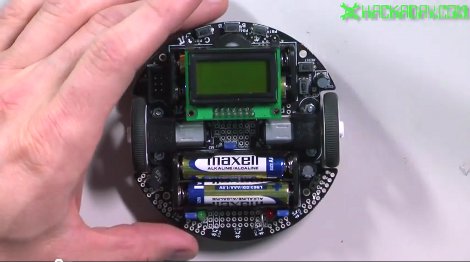
Many of you are familiar with the Arduino. Many of you hate it…* This post isn’t about the Arduino. It is about the processor that is at the heart of many Arduino boards. If you are in the camp of people who can’t understand why others dislike the Arduino so much, this series is for you. In this series of videos, [Jack] will explore how to program for the ATmega328p processor using C. If you have been programming for the Arduino, you may have had some issues with the speed of your code at points. Programming in C will allow you to wring out nearly the last ounce of processing power that the ATmega processors can provide. It will also let you access the peripherals on the processor directly and to switch between different processors when you need more (or less) capabilities.
In this first video, [Jack] shows you all of the features of the 3pi robot, which he will be using as a fancy development board for the ATmega328p. He then shows you how to get your development environment set up and then walks you through one of the sample programs provided for the 3pi robot.
*Here at Hackaday, we are officially neutral in the ongoing Arduino love/hate war. We don’t care what microcontroller is used in the hacks that we show, only that they are cool.
Video is after the break!
[youtube=http://www.youtube.com/watch?v=PzCnNKQGm9Y&w470]














I program my Arduino board using avr-gcc and writing in C. It takes a little more time but you really learn what you are doing, altought I understand why somebody not that technically oriented would choose the whole arduino environment. I like the bootloader and having a MCU board that Just Works(tm) to start rapidly prototyping, but don’t like depending on a mess of libraries that make things slow :)
There’s no video at the end, you guys have forgotten to include the unique id after ‘?v=’
would love to see the video!!!!
Here’s a temporary link to the video:
http://www.youtube.com/watch?v=PzCnNKQGm9Y
my guess; id is PzCnNKQGm9Y
http://www.youtube.com/watch?v=PzCnNKQGm9Y
Video link is here: http://www.youtube.com/watch?v=PzCnNKQGm9Y
This looks like it would make an awesome con badge =P.
I really like the new videos. Keep it up! They are fantastic.
I guess I would have liked to seen you start off with a more “generic” approach….but that’s just me.
Liked the video, but I wish you had just gone with a bare chip rather than the 3pi. The kit looks cool, but I don’t really want to shell out 100 bucks for it.
I have to agree there; not only does the robot cost a lot, but it locks you into a format that prevents the use of some of the chip features…when this was announced I expected someone with a digital still cam, a breadboard, and a pile of various bits and pieces so that various common Arduino projects could be shown using non-Arduino libraries.
I’m not saying the video wasn’t good…I just think this was overhyped a little.
I think it was a good subject for an intro video.
Yeah, I, too, was expecting something a little more…general.
The robot is nice and all, but I got excited when I first heard about the C programming series because I’m an arduino fan and am just taking a course on C, so it’s the perfect time for me to apply it. This isn’t really what I was looking forward too.
Hopefully the next videos will be a little more informational as far as how these chips are programmed raw.
I think it would be great to do a whole tutorial series on things you can do with the ATtiny25/45/85 8 pin chips directly in AVR Studio 5.
Thanks for the tutorial series. Could you please put links in each post of this series to the next (and previous) one or tag them with the same tags?
Thanks again